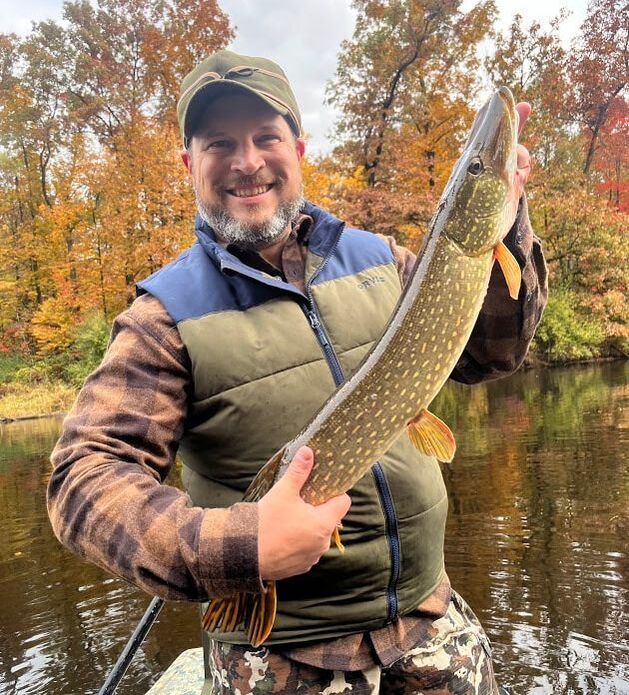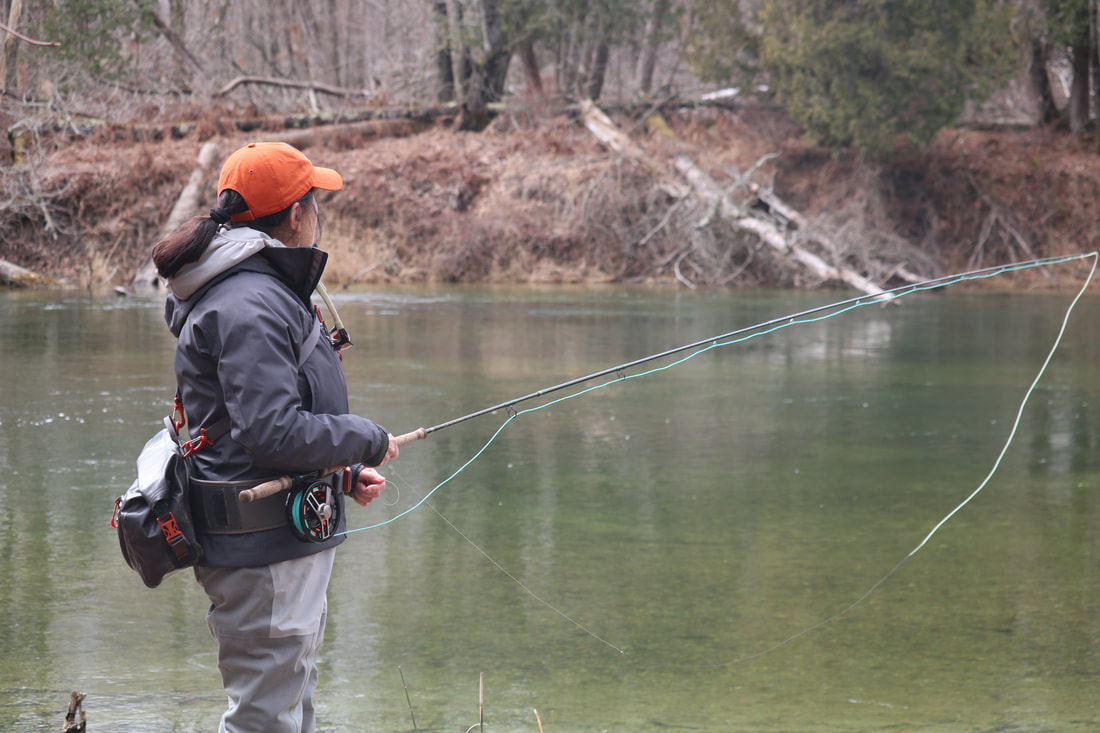|
By Drew YoungeDyke (Originally published in the Spring 2021 issue of Michigan Out-of-Doors)
The drive up US 23 along the Lake Huron shoreline is like a trip back in time to the glory days of northern Michigan lakeside cottages and motels for working-class Michiganders with extra money and time to spend. A faded mural proclaims Oscoda, Michigan, as “Paddletown, U.S.A.,” a town where the Au Sable River exits the Huron-Manistee National Forest and flows into Lake Huron. A town where you can boat in the Great Lakes, fly-fish the Au Sable, or swim in idyllic inland Van Etten Lake. It’s also a town which once supported an air base, Wurtsmith Air Force Base, which operated from 1923 to 1993. The air base had a fire training area and used firefighting foam both to put out fires and for training. In recent decades, the dangers of these firefighting foams have become more widely studied as they contained a group of chemicals known as PFAS (per- and polyfluoroalkyl substances) – nicknamed the “forever chemicals” due to their failure to break down in the environment over time – and linked to a range of human health effects including cancers and reproductive harms. The former air base – and its fire-training area – abut the Huron-Manistee National Forest and a wetland complex within it called Clark’s Marsh. Clark’s Marsh includes three ponds improved by Ducks Unlimited projects and boasts excellent wildlife habitat for waterfowl, birds, and deer, as well as warmwater fish like bluegills and pumpkinseeds. However, the PFAS contained in the firefighting foam used at Wurtsmith Air Force Base leached into the soil, where it continues to leach into Clark’s Marsh and through it to the Au Sable River, just to the other side of it. PFAS testing has resulted in consumption advisories not just for the fish in the ponds and the Au Sable River in that area, but also for white-tailed deer within a five-mile radius around Clark’s Marsh, after a single deer was found to have high levels of PFOA (perfluorooctane sulfonic acid), one of the chemicals in the PFAS family, in 2018. Tess Nelkie is an avid fly angler, a board member of Anglers of the Au Sable, a retired teacher, and owns the Nordic Sports shop in East Tawas, which sells fishing clothing, paddling gear, and rents cross-country ski equipment. I joined her and her husband on the Au Sable River, just outside of Oscoda, in March to hear how PFAS contamination and both fish and deer consumption advisories have impacted both the community and the outdoor recreation that draws people to it. “If you were to start at the headwaters, you’ve got a narrow trout stream with wild brook trout and as you come down here we have steelhead and Atlantic salmon, and soon to have Coho,” she tells me, as we’re standing thigh-deep in a beautiful stretch of the Au Sable within the Huron-Manistee National Forest. “PFAS came here from the former Wurtsmith Air Force base. When they were putting out fires they used firefighting foam which had PFAS. It went into the ground, which went into the groundwater, and now those plumes in the groundwater are moving around the area. They moved into an area called Clark’s Marsh that directly flows into the Au Sable River. And then there’s another plume which directly touches the Au Sable. And through PFAS, we now have ‘Do Not Eat’ mandates for certain resident fish because they are contaminated with PFAS and it’s unhealthy for human consumption.” Almost on queue, a patch of foam floated past us on the river. PFAS accumulates in foam on the water, though not every patch of foam is PFAS. In waters near the base, though, foam accumulates at the waters edge wherever the wind blows it: in the fallen cedars at the edges of the ponds in Clark’s Marsh; along riverbank lunker bunkers in the Au Sable; on the public park beach at Van Etten Lake, looking apocalyptic amid the foreground of empty children’s swingsets and a public water drinking fountain next to a warning sign about the foam. The Air Force recently proposed an interim remedial action to install additional filters to catch some of the PFAS leaving the base in the direction of Clark’s Marsh, but community members content that this proposed action doesn’t address the full scope of the PFAS contamination leaving the former base and that the Air Force didn’t include community input through a Resource Advisory Board in formulating its plans. Additionally, representatives from the Air Force recently stated that they did not have to design the remedial measures to comply with Michigan’s more protective standard of PFAS clean-up. It’s left a bitter taste in the mouth of the community which once embraced the base. “The difficult thing is that people don’t even know – at a scientific level – what the Air Force is presenting,” Nelkie said. “It seems like they’re trying to get out of prolonged, any kind of clean-up here. Recently, they released a remedial plan, and the remedial plan said it did not have to meet the Michigan standards for PFAS and PFOA.” Gov. Whitmer sent the Air Force a letter at the end of March invoking her authority under the federal National Defense Authorization Act to require adherence to Michigan’s stronger PFAS remediation standard through an amendment in the 2019 bill sponsored by Sen. Gary Peters (D-Mich.). “The communities around Oscoda, that have been knowingly exposed to toxic PFAS from the former Wurtsmith Air Force Base for over a decade, deserve assurance that clean-up will meet the highest standards and the Governor invoking this authority is a critical step in that process.” said Mike Shriberg, Great Lakes Regional Executive Director for the National Wildlife Federation, in a statement. “This added layer of accountability for the Air Force is a critical step in helping to restore trust and transparency in the clean-up process and ensure that people, wildlife, our land and water are the priority.” Beyond the administrative wrangling, the plans, the agencies, and the laws, it still comes down to the water. The community wants clean water and the natural resources that go with it. That’s what Tess Nelkie wants to see. “Make it so people can eat fish again. Make it so people can eat deer here. Make it so people don’t have to worry here that when they shoot a duck or if they’re hunting that they have to worry if they’re poisoning themselves by eating the wildlife.” |
AUTHOR
Drew YoungeDyke is an award-winning freelance outdoor writer and a Director of Conservation Partnerships for the National Wildlife Federation, a board member of the Outdoor Writers Association of America, and a member of the Association of Great Lakes Outdoor Writers and the Michigan Outdoor Writers Association.
All posts at Michigan Outside are independent and do not necessarily reflect the views of NWF, Surfrider, OWAA, AGLOW, MOWA, the or any other entity. ARCHIVES
June 2022
SUBJECTS
All
|



 RSS Feed
RSS Feed